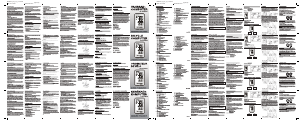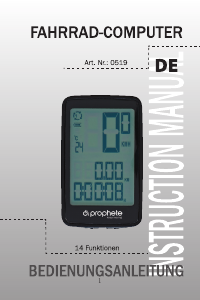
TABLE OF CONTENTS
1. SCOPE OF USE
2. SAFETY AND MAINTENANCE
2.1 Safety instructions
2.2 Repairs
2.3 Operating environment conditions
2.4 Ambient temperature
2.5 Electromagnetic compatibility
2.6 Battery operation
2.7 Disposal
2.7.1 Battery disposal
2.7.2 Bicycle computer disposal
2.7.3 Packaging disposal
2.8 Maintenance
2.9 Cleaning and care
2.10 Storage
2.11 Notes on these operating instructions
2.12 Scope of delivery
3. DISPLAY AND FUNCTION KEYS
4. ASSEMBLY
4.1 Bicycle computer mount and bicycle computer
4.2 Fitting the sensor
5. INITIAL OPERATION
5.1 Switching on the bicycle computer for the fi rst time
5.2 Setting the tyre size
5.3 Setting the clock
5.4 Bicycle computer check
5.5 Restart / Reset
5.6 Automatic starting/stopping of readings
6. MODES / FUNCTIONS
6.1 Resetting the route data to zero
7. REPLACING THE BATTERIES
7.1 Bicycle computer
8. DECLARATION OF CONFORMITY
9. DESCRIPTION OF ERRORS
10. WARRANTY PROVISIONS
From 07/2011
1. SCOPE OF USE
This bicycle computer has been designed solely for use as a bicycle computer.
Bicycle computers provide information on the speed and distances covered. Any use
other than described in these operating instructions is not permitted and may result
in damage and injuries. No liability shall be assumed by us for any improper use. You
will fi nd more notes and explanations in the operating instructions.
2. SAFETY AND MAINTENANCE
2.1 Safety instructions
Please read this chapter carefully and follow all the instructions given. This will
guarantee reliable operation and a long service life of your bicycle computer. Please
keep the packaging and the operating instructions in a safe place, for the purpose
of passing them on to a new owner should you sell or give the bicycle computer
to somebody.
Under no circumstances open the housing of the bicycle computer or sensor, since
none of the parts inside require maintenance (the exception here is when you
open the battery compartment to insert or replace the batteries – refer to section
7 Replacing the batteries). Do not place any objects on the bicycle computer and
do not apply any pressure to the display, as this could cause damage to it. To avoid
damage, do not touch the display with any sharp objects.
2.2 Repairs
In the event of any necessary repairs or technical problems, please contact
exclusively our service centre. You will fi nd the address in the warranty provisions
(section 10).
2.3 Operating environment conditions
The bicycle computer is splash-water protected. Ensure that your bicycle computer
is not exposed to wet conditions or extended conditions of high humidity, and avoid
dust, heat and extended periods of direct sunlight. Failure to observe these instruc-
tions may result in malfunctioning of, or damage to, the bicycle computers.
2.4 Ambient temperature
The bicycle computer is designed for permanent operation and storage at ambient
temperatures between -10° and +50°C.
2.5 Electromagnetic compatibility
As far as possible, avoid using the bicycle computer in close proximity to electronic
devices such as computers, printers, televisions, mobile telephones or radios, as
devices with strong EMC radiation may interfere with or impede radio reception.
2.6 Battery operation
The bicycle computer is operated by a LR 44 battery. The following text will provide
you with some information on how to handle batteries:
Only replace the batteries with an equivalent battery type. Do not charge or
reactivate batteries using any other means. Do not take batteries apart, throw
them into fi res or short-circuit them. Always keep batteries out of the reach of
children. Batteries may cause fatal injury if swallowed. For this reason, keep the
batteries and the bicycle computer out of the reach of small children. Seek medical
assistance immediately if a battery has been swallowed. If required before inserting
the batteries, use a slightly damp cloth to clean the devices and battery contacts
and dry thoroughly. Be careful with leaking batteries! Avoid contact with skin, eyes
and mucous membranes! If there is any contact with battery fl uid, immediately
rinse the areas affected with plenty of water and directly consult a doctor. Batteries
do not tolerate heat. Ensure that the computer and its inserted batteries do not
become too hot. Non-observance of these instructions may result in damage and
even cause the batteries to explode. Temperatures below 0°C may have an adverse
effect on the battery life. For information on replacing the batteries refer to section
7 Replacing the batteries.
Note: Please do not leave the bicycle computer in a place where it will be
exposed to extreme heat or cold. Extreme cold will cause weakening of the
batteries (refer to section 2.4).
2.7 Disposal
2.7.1. Battery disposal
Batteries are hazardous waste. To properly dispose of them, there are corresponding
collection points available in shops that stock batteries as well as those provided
by municipal authorities.
2.7.2 Bicycle computer disposal
When you wish to get rid of your bicycle computer, dispose of it according to the
current regulations. Information on this is available from the municipal authorities.
2.7.3. Packaging disposal
Dispose of the bicycle computers packaging according to the current regulations.
Information on this is available from the municipal authorities.
2.8 Maintenance
Warning! There are no parts inside the housing of the bicycle computer that
require maintenance or cleaning.
2.9 Cleaning and care
Only use a soft, damp, lint-free cloth to clean the bicycle computer. Do not use
solvents, corrosive or gaseous cleansing agents. Ensure that there are no water
droplets remaining on the display. Water may cause permanent discolouration. Do
not expose the bicycle computer display to bright sunlight or ultraviolet radiation.
2.10 Storage
Remove the battery when the bicycle computer is not in use for an extended period.
To store the bicycle computers please observe the note in section 2.3 Operating
environment conditions and section 2.4 Ambient temperature. Ensure that the
bicycle computer is securely stored. Avoid high temperatures (e.g. by direct sunlight)
and a permanently damp environment.
4. ASSEMBLY
4.1 Bicycle computer mount und bicycle computer
Attach the bicycle computer mount (A) to the handlebars using the corresponding
support and cable ties (D). Insert the bicycle computer into the bicycle computer
mount from the front until it engages. Then turn the bicycle computer to the desired
viewing angle. To remove the bicycle computer, press down on the catch.
4.2 Fitting the sensor
Attach the sensor to the fork using the cable ties (D) and support as illustrated in
the following diagram. Ensure that you lay the cable so that it is not pulled too taut
or breaks when turning the handlebars. Also ensure that it cannot get caught up in
the front wheel spokes when you are riding your bicycle. If necessary, fi x in place
with cable tie. Place the magnet on the spokes of the front wheel and fasten using
a locking ring and screw. Ensure that the magnet is aligned with the sensor with a 2
mm clearance (as shown in the next diagram).
Magnet clearance 4 mm
3. DISPLAY AND FUNCTION KEYS2.11 Notes on these operating instructions
We have structured the operating instructions for this bicycle computer in such
a manner that you can readily fi nd the information required by consulting the
table of contents by topic. If you have any other queries, please contact us at the
following address:
Service address: Prophete GmbH u. Co. KG
Lindenstrasse 50
D-33378 Rheda-Wiedenbrück
+49 (0) 5242 4108-59
2.12 Scope of delivery
Bicycle computer
A = Bicycle computer mount with sensor
B = Bicycle computer mount with sensor
C = LR 44 battery for bicycle computer
D = 9 cable ties (2 lengths)
A
B
D
C
Reset keyMode key
0526_layout_en.indd 20526_layout_en.indd 2 10.08.2011 8:49:14 Uhr10.08.2011 8:49:14 Uhr












Join the conversation about this product
Here you can share what you think about the Prophete 0526 Cycling Computer. If you have a question, first carefully read the manual. Requesting a manual can be done by using our contact form.